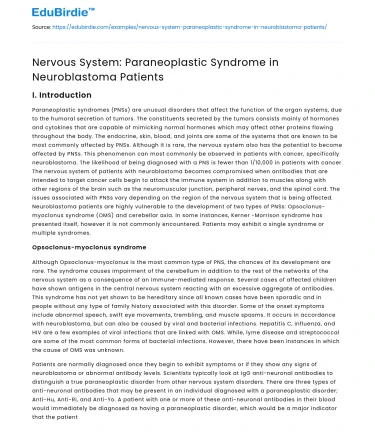I. Introduction
Paraneoplastic syndromes (PNSs) are unusual disorders that affect the function of the organ systems, due to the humoral secretion of tumors. The constituents secreted by the tumors consists mainly of hormones and cytokines that are capable of mimicking normal hormones which may affect other proteins flowing throughout the body. The endocrine, skin, blood, and joints are some of the systems that are known to be most commonly affected by PNSs. Although it is rare, the nervous system also has the potential to become affected by PNSs. This phenomenon can most commonly be observed in patients with cancer, specifically neuroblastoma. The likelihood of being diagnosed with a PNS is fewer than 1/10,000 in patients with cancer. The nervous system of patients with neuroblastoma becomes compromised when antibodies that are intended to target cancer cells begin to attack the immune system in addition to muscles along with other regions of the brain such as the neuromuscular junction, peripheral nerves, and the spinal cord. The issues associated with PNSs vary depending on the region of the nervous system that is being affected. Neuroblastoma patients are highly vulnerable to the development of two types of PNSs: Opsoclonus-myoclonus syndrome (OMS) and cerebellar axia. In some instances, Kerner -Morrison syndrome has presented itself, however it is not commonly encountered. Patients may exhibit a single syndrome or multiple syndromes.
Opsoclonus-myoclonus syndrome
Although Opsoclonus-myoclonus is the most common type of PNS, the chances of its development are rare. The syndrome causes impairment of the cerebellum in addition to the rest of the networks of the nervous system as a consequence of an immune-mediated response. Several cases of affected children have shown antigens in the central nervous system reacting with an excessive aggregate of antibodies. This syndrome has not yet shown to be hereditary since all known cases have been sporadic and in people without any type of family history associated with this disorder. Some of the onset symptoms include abnormal speech, swift eye movements, trembling, and muscle spasms. It occurs in accordance with neuroblastoma, but can also be caused by viral and bacterial infections. Hepatitis C, influenza, and HIV are a few examples of viral infections that are linked with OMS. While, lyme disease and streptococcal are some of the most common forms of bacterial infections. However, there have been instances in which the cause of OMS was unknown.
Save your time!
We can take care of your essay
- Proper editing and formatting
- Free revision, title page, and bibliography
- Flexible prices and money-back guarantee
Patients are normally diagnosed once they begin to exhibit symptoms or if they show any signs of neuroblastoma or abnormal antibody levels. Scientists typically look at IgG anti-neuronal antibodies to distinguish a true paraneoplastic disorder from other nervous system disorders. There are three types of anti-neuronal antibodies that may be present in an individual diagnosed with a paraneoplastic disorder; Anti-Hu, Anti-Ri, and Anti-Yo. A patient with one or more of these anti-neuronal antibodies in their blood would immediately be diagnosed as having a paraneoplastic disorder, which would be a major indicator that the patient has some sort of underlying cancer. The blood of an adult with OMS would contain anti-neuronal nuclear antibody, type I (Anti-Hu), while the blood of a child would have anti-neuronal nuclear antibody, type II (Anti-Ri). In most cases, paraneoplastic disorders are diagnosed before the cancer itself. Nonetheless, a CT scan or MRI could be performed in order to identify any signs of neuroblastoma which could potentially save a patient’s life, if it is detected early enough.
There is currently not a single remedy for OMS available, however it can be treated with chemotherapy, corticosteroids, ACTH, immunotherapy, and surgery. Surgery is the most recommended type of treatment in the case of patients with tumors. In spite of this, the removal of a tumor does not guarantee the seize or improvement of neurologic symptoms. There are numerous cases of patients that have continued to exhibit abnormal behavior even after the complete removal of a tumor. A mixture of several medications could essentially increase the chances of a successful outcome in comparison to that of surgery. Studies have shown that immunotherapy with the human intravenous immunoglobulins (IVIG) have dramatically improved symptoms in as much as 83 percent of patients. However, immunotherapy appears to have a more significant effect in children than it does in adults.
On the other hand, despite the effectiveness of immunotherapy in children, relapse is common in more than half of the patients, which triggers the return of onset syndromes such as dancing eyes and muscle jerking. A patient has a higher chance of making a full recovery after a bacterial or viral infection, as opposed to that of someone with neuroblastoma. Recovery depends on the severity of a patient’s symptoms, therefore, a patient with mild symptoms has an increased likelihood of gaining full neurological function in comparison to a patient that experiences severe symptoms. It may take anywhere from months to years after the interruption of immunotherapy before a relapse occurs. Although, stress, a mild fever, or a case of the common cold have proven to be sufficient to generate a relapse in patients.






 Stuck on your essay?
Stuck on your essay?

